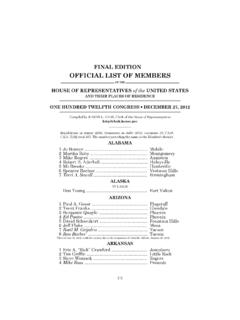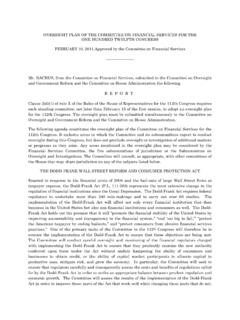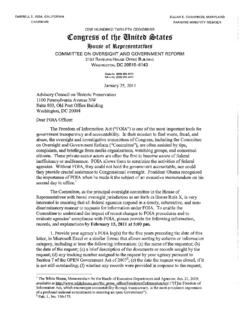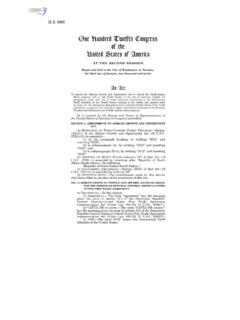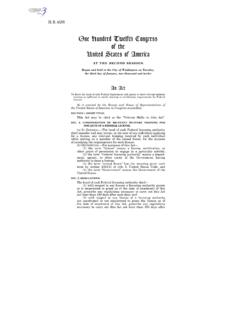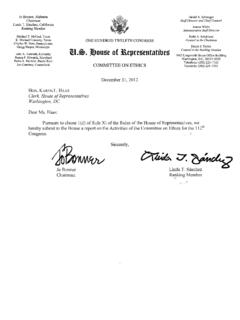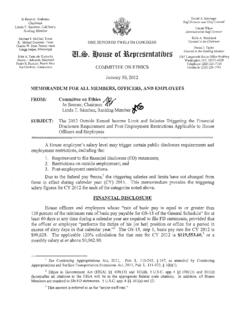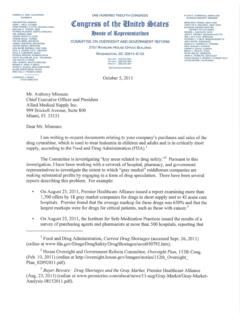Transcription of Operation Odyssey Dawn (Libya): Background and Issues …
1 CRS Report for CongressPrepared for Members and Committees of congress Operation Odyssey dawn (Libya): Background and Issues for congress Jeremiah Gertler, Coordinator Specialist in Military Aviation March 30, 2011 Congressional Research Service7-5700 R41725 Operation Odyssey dawn (Libya): Background and Issues for congress Congressional Research Service Summary This report provides an overview of military operations in Libya under command from March 19 to March 29, 2011, and the most recent developments with respect to the transfer of command of military operations from the United States to NATO on March 30. The ongoing uprising in Libya against the government of Muammar al Qadhafi has been the subject of evolving domestic and international debate about potential international military intervention, including the proposed establishment of a no-fly zone over Libya.
2 On March 17, 2011, the United Nations Security Council adopted Resolution 1973, establishing a no-fly zone in Libyan airspace, authorizing robust enforcement measures for the arms embargo established by Resolution 1970, and authorizing member states to take all necessary measures .. to protect civilians and civilian populated areas under threat of attack in the Libyan Arab Jamahiriya, including Benghazi, while excluding a foreign occupation force of any form on any part of Libyan territory. In response, the United States established Operation Odyssey dawn , the contribution to a multilateral military effort to enforce a no-fly zone and protect civilians in Libya.
3 Military operations under Odyssey dawn commenced on March 19, 2011. and coalition forces quickly established command of the air over Libya s major cities, destroying portions of the Libyan air defense network and attacking pro-Qadhafi forces deemed to pose a threat to civilian populations. From the outset of operations , the Obama administration declared its intent to transfer command of operations over Libya to a coalition entity. On March 30, 2011, NATO assumed command of all aspects of coalition military operations . Establishment of the initial no-fly zone over Libya went smoothly. One aircraft was lost due to mechanical malfunction, but the crew were rescued.
4 Estimates of the cost of the initial Operation range between $400 million and $1 billion. participation in Operation Odyssey dawn and NATO operations around Libya raises a number of questions for congress , including the role of congress in authorizing the use of force, the costs of the Operation , the desired politico-strategic end state, the role of military forces in an Operation under international command, and many others. (A note on transliteration: The name of Muammar al Qadhafi is transliterated in many ways by various sources. This paper refers to him as Qadhafi except when quoting other documents, wherein his name is represented as it appears in the source.)
5 Operation Odyssey dawn (Libya): Background and Issues for congress Congressional Research Service Contents Overview .. 1 Recent Developments: Transfer from to NATO 1 Prior to Military operations : Background , Select Views, and 2 Administration Perspectives .. 2 President Obama s Remarks on Military 3 Congressional Perspectives .. 4 International Involvement .. 5 United Nations Authorization .. 5 The Arab 6 Military operations Operation Odyssey 7 Libyan Air 9 Libyan Air 10 Geography .. 10 Concept of 11 Assets Involved in Operation Odyssey 11 Command Structure .. 13 Involvement of NATO, NATO Member States, and Coalition 15 NATO Operation Unified Protector.
6 16 France Operation 17 United Kingdom Operation 18 Other Participating NATO Member States .. 19 Non-NATO Coalition 20 Issues for congress .. 20 What Is the Role of Congressional Authorization?.. 20 21 Historical Costs as a 23 Costs of Initial Libyan operations .. 23 Other Issues for 28 Additional CRS 28 Figures Figure 1. Initial No-Fly Zone .. 8 Figure 2. Expanded No-Fly Zone .. 9 Figure 3. Maritime Assets in Operation Odyssey dawn .. 12 Figure 4. Commanders ..14 Tables Table 1. Estimated Costs of Libyan operations , March 19-March 28, 25 Operation Odyssey dawn (Libya): Background and Issues for congress Congressional Research Service Table 2.
7 Costs of Selected Combat Air operations , 27 Contacts Author Contact Information ..29 Operation Odyssey dawn (Libya): Background and Issues for congress Congressional Research Service 1 Overview1 In the weeks prior to commencement of Operation Odyssey dawn , the ongoing uprising in Libya against the government of Muammar al Qadhafi was the subject of domestic and international debate about potential international military intervention, including the proposed establishment of a no-fly zone over Libya. On March 17, 2011, the United Nations Security Council adopted Resolution 1973 (UNSCR 1973), establishing a no-fly zone in Libyan airspace, authorizing robust enforcement measures for the arms embargo established by Resolution 1970, and authorizing member states to take all necessary measures.
8 To protect civilians and civilian populated areas under threat of attack in the Libyan Arab Jamahiriya, including Benghazi, while excluding a foreign occupation force of any form on any part of Libyan territory. Policy debates in the United States, allied countries, and the Middle East have intensified in parallel with the authorization, launch, and continuation of and coalition military operations . Third parties, including the government, have staked out firm political positions demanding Qadhafi s ultimate departure, but opposition forces have yet to demonstrate that they have the capacity to dislodge Qadhafi on their own, and Resolution 1973 calls for an immediate cease-fire and dialogue, which Qadhafi may yet embrace in a bid to stay in power.
9 For the United States, reconciling a long-term objective of regime change with participation in military action to enforce a UN Security Council resolution that does not expressly endorse that goal is a particular challenge. Some observers have warned that the use of force whether by external parties, Libyan rebels, or some combination of the two to affect regime change in Tripoli may have unpredictable consequences for the long term stability of the country and the region. This report provides an overview of military operations under command from March 19 to March 29, 2011, and the most recent developments with respect to the transfer of command of military operations from the United States to NATO on March 30.
10 For more information on the conflict in Libya, see CRS Report RL33142, Libya: Unrest and Policy, by Christopher M. Blanchard. Recent Developments: Transfer from to NATO Command2 On March 27, 2011, after just over a week of coalition air operations under command, the North Atlantic Treaty Organization (NATO) announced that it would take over command and control of all ongoing military operations in Libya. According to NATO Secretary General Anders Fogh Rasmussen, the goal of NATO s Operation Unified Protector is to protect civilians and civilian-populated areas under threat of attack from the Gaddafi regime. This entails (1) enforcing a UN-mandated arms embargo; (2) enforcing a no-fly zone over Libyan territory; and (3) protecting civilians and civilian population areas from being attacked by military forces from the Qadhafi regime.










